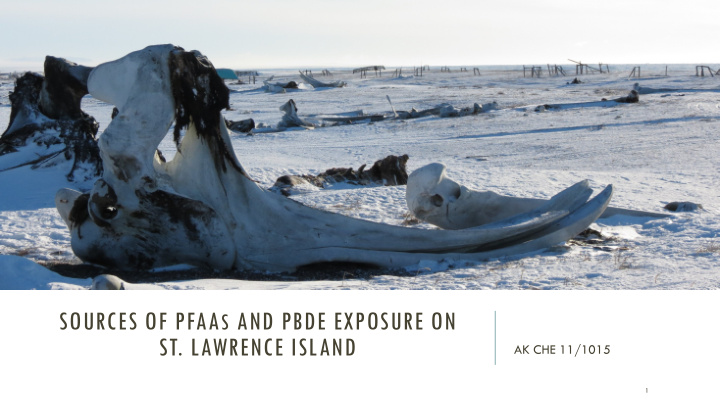



SOURCES OF PFAA S AND PBDE EXPOSURE ON ST. LAWRENCE ISLAND AK CHE 11/1015 1
PCB contamination PCBs 6 PCBs US average 4 ppb ww 2 0 Gambell Savoonga FUD site 2
Pesticide contamination 900 Serum Pesticide Concentrations 800 mean and standard deviation 700 600 ng/g lw 500 400 300 200 100 0 Sum-DDT Sum-Chlordane Hexachloro- Mirex benzene Gambell Savoonga NEC military site 3
Other Sources of Exposure? • Global transport and distillation • Accumulation of persistent organic pollutants in the Arctic • Traditional diets • Consumption of long lived and high trophic level animals • Long heating season • Low air exchange and potential for accumulation of indoor pollution 4
PFAAs Characteristics • Utilized for a variety commercial and industrial applications • Surfactants, stain and water proofing, cookware, food packaging, firefighting foams • Persistent and bioaccumulative Health Effects • Evidence for immunotoxicity • Reduced Fertility • Thyroid hormone disruption Sources • Diet, and indoor dust and air Image: Wikimedia Commons 5 PFOS-2D-skeletal.png
PBDES Characteristics • Flame retardants added to numerous consumer products: furniture, electronic, fabric • Persistent, bioacummulative Health effects • Cognitive/behavioral effects in children • Anti-androgenic effects and reduced fertility • Thyroid hormone disruption Sources • House dust and animal products in diet Image: Wikimedia commons PBDE-209.png
Overall Study Design Indoor exposure • Dust sample Human biomonitoring Health outcome from 49 homes Serum Samples from Thyroid hormone 86 individuals (f)T 3 , (f)T 4 , TSH ages 18-45 Environmental ~One man and one monitoring women from each • Sentinel Fish home 7
RESULTS Median and 95th percentile among Males Median and 95th percentile among Females 50 50 40 40 ng/ml 30 30 20 20 10 10 0 0 PFOA PFNA PFDA PFUnA PFHxS PFOS PFOA PFNA PFDA PFUnA PFHxS PFOS SLI US SLI US 8 SLI= St. Lawrence Island US= United States general population ages 18-45, 07-08 NHANES
Relative concentrations In Dust and Serum 70 60 50 Percent Total 40 30 20 10 0 PFPeA PFHxA PFHpA PFOA PFNA PFDA PFUnA PFDoA PFBS PFHxS PFOS Dust Serum 9
Median and 95th percentiles among Males Median and 95th percentiles among females 100 100 80 80 ng/g lipid 60 60 40 40 20 20 0 0 BDE_47 BDE_99 BDE_100BDE_153BDE_183BDE_209 BDE_47 BDE_99 BDE_100 BDE_153 BDE_183 BDE_209 SLI US SLI US SLI= St. Lawrence Island US= United States general population ages 20-39, 07-08 NHANES 10
Relative concentrations in Dust and Serum 70 60 Percent Total 50 40 30 20 10 0 Dust Serum 11
Comparison by village Gambell vs. Savoonga 80 ppb in blood 60 40 20 0 PBDE PFC Gambell Savoonga 12
PBDEs in Stickleback 1400 ppb (ng/g) lipid weight 1200 1000 800 600 400 200 0 1 1 1 2 2 3 3 3 3 3 3 3 3 3 3 Troutman Lake Tapi River FUD site BDE-47 BDE-99 BDE-153 BDE-209 Total PBDE 13
PFAAs in Stickleback 20 ppb (ng/g) wt weight 15 10 5 0 1 1 1 2 2 3 3 3 3 3 3 3 3 3 3 Troutman Lake Tapi River FUD site PFOA PFNA PFOS 14
What have we learned so far? Where is PBDE exposure coming from? We think that dust is an important source of PBDEs PBDEs are present in fish on the island, and diet is probably a source of PBDEs Where are PFAAs coming from? We think dust a minor source of PFAAs A few PFAAs are higher on SLI than in the general US population Diet is probably an important source of PFAAs, especially PFNA and PFUNA Stickleback data suggest both PBDEs and PFAAs are accumulating on the Island In general, the same PBDEs and PFAAs are present in humans and stickleback 15
Recommend
More recommend